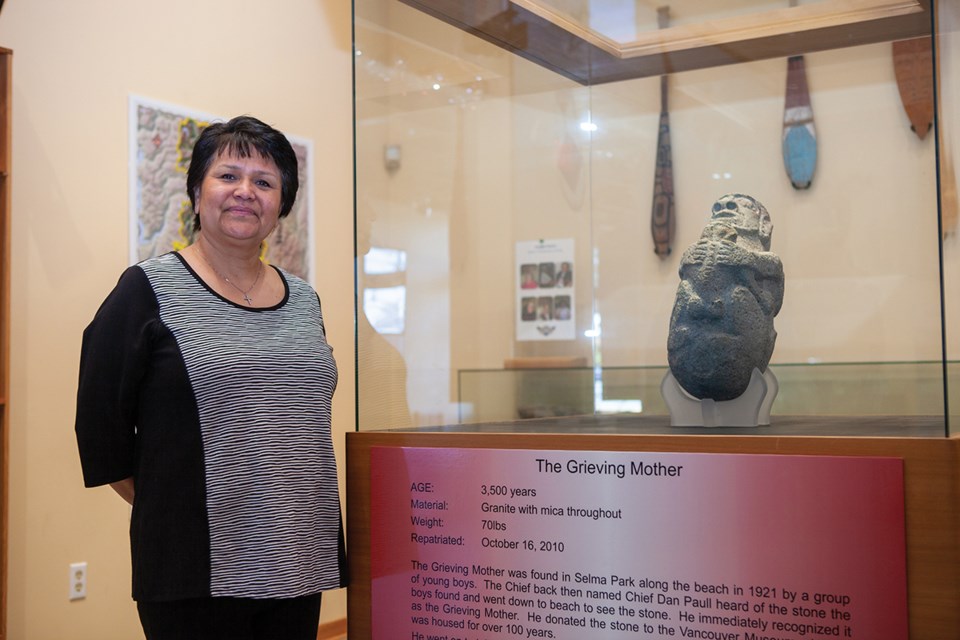Following a two-year closure, the tems swiya Museum of the shíshálh Nation reopened its doors on April 11, restoring public access to cultural artifacts and ecological remnants that span over 10,000 years of human history.
“When we closed [in 2020] because of COVID, it was like, ‘What are we going to do now?’” said curator ch’elkwilwet Raquel Joe. “I missed everybody.”
Dragging the facility’s portable signage into position, Joe added: “And then, to get ready for today, we had to deal with two years worth of dust.”
The museum’s guest book tells the story: no entries since mid-2021, when the 26-year-old facility opened tentatively for a few days in the midst of its two-year coronavirus shutdown.
Under normal circumstances, the museum welcomes between 100 and 200 visitors each week, with numbers rising during peak tourism season.
The museum is part of a sprawling campus that forms the administrative and cultural headquarters of the shíshálh Nation. The complex is built on the site of the former Sechelt (St. Augustine’s) Indian Residential School, which operated between 1912 and 1975. Its last vestiges were burned in 2008.
In the midst of the museum’s closure, unmarked gravesites identified in May 2020 by the Tk’emlúps te Secwépemc First Nation at the former Kamloops Indian Residential School triggered similar investigations across the country. Archaeologists using ground-penetrating radar began a detailed search of the shíshálh grounds this February. The experts have concluded their fieldwork, said Joe, with findings still to be analyzed and shared.
A pre-pandemic exhibit depicting the impact of the residential school remains on display. “I was going to take it down,” Joe said. “But seeing it more and more on the news, where the ground penetrating radar is going, I’m going to leave it up for now.”
Meanwhile, preparations are under way for a new exhibit that will depict the involvement of shíshálh Nation members in the Sleepy Hollow Rod Run and Show ‘n’ Shine organized annually by the Coasters Car Club. The exhibit will feature photographs of shíshálh community members posing with classic automobiles.
Joe’s plans for the hot rod gallery—brimming with grins and gas-guzzlers—contrast with the solemn figures depicted in the display titled kw’en-usitsht tems stutula.
The name means “We are face-to-face with our ancestors.” Working from 4,000-year-old remains, researchers from the shíshálh Nation, the University of Toronto, and the Canadian Museum of History created animated renderings of a high-status shíshálh family. The reconstruction was the first of its kind in North America when it opened in 2017.
Overhead, kwenten ?e te sinkwu—Guardian of the Sea, an orca whale skeleton recovered in 2016—is suspended adjacent to lithe canoes used for saltwater racing. The museum’s compact footprint allows only a tenth of its collections to be displayed.
According to Joe, new archeological finds and cedar baskets donated by private collectors are added to storage each week. Several artifacts are awaiting repatriation from the Sunshine Coast Museum and Archives in Gibsons, which has also provided technical support for tems swiya’s new database software.
The long closure interrupted the race to preserve an even more fleeting treasure. “she shashishalhem is a beautiful, beautiful language,” said Joe. “At one point in time we had 40 or 50 elders who were fluent speakers. That’s how we developed our dictionary. Now we have maybe a few fluent speakers. And at the residential schools, it was instilled in them not to speak it.”
The tems swiya (“our world”) Museum is open Monday through Saturday from 9 a.m. to 4 p.m., with admission by donation.


